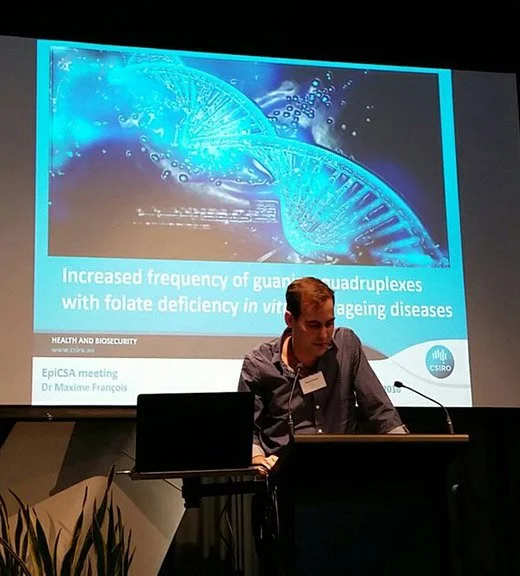First Annual EpiCSA Research Meeting a great success
Recent Posts
Spotlight on: Melanie Eckersley-Maslin 25 November 2022
Spotlight on: Jessamy Tiffen 25 July 2022
ECR Spotlight on: Alex Woodworth 16 July 2022
Epigenetics 2022: Four weeks left for poster abstract submissions! 15 July 2022
Emma Whitelaw ECR Publication Award 30 June 2022
Epigenetics 2022 – Meet the speakers 17 June 2022
ECR Spotlight on: Kate Giles 31 May 2022
Spotlight on: Luciano Martelotto 30 May 2022
Epigenetics 2022 speakers announced 20 April 2022
Spotlight on: Hamish King 18 April 2022
ECR Spotlight on: William Schierding 6 April 2022
Spotlight on: Louise Bicknell 14 March 2022
Categories
News (57)
Opportunities (3)
Publications (7)
Spotlight on … (16)
World epi news (2)
Archived news
2022 (12)
2021 (9)
2020 (9)
2019 (1)
2018 (6)
2017 (6)
2016 (6)
2015 (17)
2014 (1)
by AEpiA| Nov 07, 2017 | Meeting Highlights, News
The Epigenetics Consortium of South Australia (EpiCSA) held its first Annual Research Meeting on 13th October, with a busy one-day program including a keynote talk by Professor Ryan Lister of University of Western Australia.
Paniz Tavakoli and EpiCSA’s Tina Bianco-Miotto
First Annual EpiCSA Research Meeting organisers
Ryan Lister
Kavita Panir
Maxime Francois
Formed in 2015, EpiCSA has brought together epigenetics researchers from diverse disciplines with a number of workshops and meetings to date, the first Annual EpiCSA Research Meeting being a major highlight. The meeting was held at the auditorium of the South Australian Health and Medical Research Institute. Dr Tina Bianco-Miotto, EpiCSA Chairperson, who led the organisation of the meeting, said, “Our first annual research meeting was a wonderful success. We were honoured to have leading epigenetic researchers speaking, and the event also gave early career researchers and students the opportunity to showcase their work.” AEpiA was delighted to sponsor two awards at the event: The award for Best Student Poster Talk was presented to Saira Ali of Flinders University, and The Best Student Poster prize was awarded to Paniz Tavakoli of CSIRO and University of Adelaide. The title of Saira’s poster was Epigenetic regulation of gene expression in colorectal cancer (CRC) cells, and in her talk she discussed her work using high-throughput functional screens to identify microRNAs that might sensitise CRC cells to the anti-tumorigenic molecule butyrate. Saira is currently validating a number of microRNA targets that may have potential as tumour suppressors. Paniz’s poster was entitled Folate deficiency increases guanine-quadruplexes (G4) frequency and DNA damage in Werner syndrome. Werner syndrome is a rare autosomal disease characterised by the premature onset of several age-associated pathologies, and Paniz presented her work characterising the links between folate deficiency and the presence of DNA G4 structures and altered DNA methylation profiles in cells from patients with this condition. Saira and Paniz were kind enough to write about some of the highlights of the EpiCSA meeting for them – please read them below. AEpiA congratulates EpiCSA on another successful event, and we look forward to hearing more in 2017.
Saira Ali writes:
Attending the EpiCSA Annual Research Meeting 2016, I was very impressed by the amazing epigenetics research being performed by our local students and researchers. There were two talks by Benjamin Mayne and Kavita Panir, both from University of Adelaide, that particularly drew my attention. Benjamin spoke about DNA methylation changes observed in the placenta of pregnant women. I found his research very interesting because Benjamin collated DNA methylation data from publicly available data sets and he identified methylation changes in CpG sites that could be used to predict the gestational age of the placenta. This highlights how important it is to share your data because someone else may ask a completely different question from you and discover something novel from the same data set! Kavita spoke about the effect of knocking out miR-223 in mice on the formation of endometriosis-like lesions. Kavita’s talk was interesting because she demonstrated that the absence of this miRNA affects the size and weight of the lesions formed in the miR-223 knockout mice. For me it is really interesting to see miRNA research from people studying different diseases and realise how different the role of an individual miRNA can be in different tissues. This same miRNA has been associated with poor prognosis in patients with colorectal cancer (my area of study) and tumour metastasis.
Paniz Tavakoli writes:
Maxime François (CSIRO, Health and Biosecurity) gave an elegant presentation on the epigenetic importance of G-quadruplexes, which are DNA tetra-stranded secondary conformations, in a context of human diseases and nutrition. It has been proposed that these structures can affect the stability of our genome and have been found to be elevated in aging disorders, mild cognitive impairment in particular. His results showed that exposing cells to folate deficiencies had repercussions on the appearance of these structures and genome stability, emphasising the important roles of nutrients at the cellular level. This talk grabbed my attention by introducing quantitative imaging, a different approach for measuring G-quadruplexes other than bioinformatics and computational biology methods mentioned in previous presentations that day. As stated, this developed technique requires precise targeting of these structures within human DNA by a specific antibody and was shown to be adaptable for high-throughput. Since sequencing is expensive and requires expertise in bioinformatics, this method may be a powerful tool for epigenetic studies.
Saira Ali and EpiCSA’s Tina Bianco-Miotto







